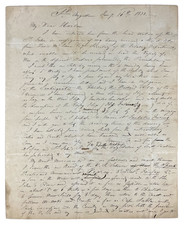This 1837 work by John James Audubon, from the double-elephant folio first edition of his Birds of America, captures the Evening Grosbeak, "Fringilla vespertina", and the Black-headed Grosbeak, "Fringilla maculata", in an evocative display of natural history illustration. Expertly drawn by Audubon and engraved, printed, and colored by Robert Havell Jr., the image is an exquisite highlight from the greatest bird book ever made.
Audubon's choice to include these particular species is notable. The Evening Grosbeak and Black-headed Grosbeak, perched delicately on thin branches, are depicted with precision, highlighting their distinct plumage and postures. The dynamic composition, featuring a pair of birds reaching for a Comma Butterfly, adds a narrative element to the scientific portrayal, inviting viewers to contemplate the birds' behavior and habitat. This interaction between avian and insect life forms a tableau of the natural world.
Further intrigue is added by Audubon's initial intention to depict the Pine Grosbeak, as evidenced by the overwritten text and reference to Plate CCCLVIII. This detail, along with the provenance of the bird skins likely acquired from Thomas Nuttall's western collection, paints a picture of Audubon's process and the historical context of his work.
Evening Grosbeak
The Evening Grosbeak (Coccothraustes vespertinus) is a striking bird species known for its sizeable build and vivid plumage, primarily found in North America. Males are particularly notable for their vibrant yellow bodies and striking black and white wings, which are accentuated by a large, conical bill that is adept at cracking seeds. The females and juveniles display a more subdued olive-yellow coloration. These birds are often found in mixed coniferous and deciduous forests, where they feed on a diet consisting mainly of seeds, berries, and insects. During winter, Evening Grosbeaks are known to migrate in flocks to lower elevations or more southerly regions, where they often visit bird feeders, bringing splashes of color to winter landscapes.
Black-headed Grosbeak
The Black-headed Grosbeak (here called the Spotted Grosbeak), known scientifically as Pheucticus melanocephalus, is a strikingly vibrant bird that inhabits the woodlands of North America, especially along the western coast and in the Rocky Mountains. Distinguished by its black head and bright orange or yellow underparts, the male of the species is particularly eye-catching, while the female is more subdued in coloration, featuring brown and grey tones with spattered orange hues. These medium-sized birds are known for their melodious and rich song, which often includes a variety of whistles and warbles, resembling that of the American Robin but more fluent and varied. In terms of diet, the Black-headed Grosbeak is versatile, feeding on insects, seeds, and fruits, and is particularly fond of snacking on beetles, caterpillars, and spiders. One notable aspect of their behavior is their tendency to crack open the hard shells of seeds and beetles with their strong beaks. During breeding season, they exhibit a unique cooperative behavior, with both males and females sharing responsibilities for nest building, incubating eggs, and feeding the young. The Black-headed Grosbeak plays a significant ecological role in controlling insect populations and dispersing seeds, contributing to the health of their woodland habitats.
John James Audubon's Double Elephant Folio Birds of America: The Havell Edition (1827-1838)
The present hand-colored original Audubon print comes from the Havell double elephant folio edition of Birds of America, the greatest color plate book ever made. This work was Audubon's magnum opus and was published at immense expense over almost a decade, between 1827 and 1838. The Havell Edition of Birds of America included 435 hand-color aquatinted plates, and it is estimated that between 165 and 175 complete sets were produced. Today, a given individual image probably exists in no more than 60 loose examples, though for some plates the number will be much lower. Audubon aquatint engravings from the Havell Edition were printed on J. Whatman wove paper, the best paper in the world at the time - and to this day an exceptional fine art paper. The sheets of paper were approximately 26½ x 39½ inches untrimmed. Importantly, they all feature watermarks that are variations on "J.Whatman" or "J.Whatman / Turkey Mill" with the date of manufacture sometimes appended. In addition to the name of the bird depicted (and sometimes its gender, age, and botanical notes as well) Audubon's name and the name of the engraver also appear printed on Havell Edition plates. On the lower left side is printed "Drawn from nature by John James Audubon F.R.S. and F.L.S." (Fellow of the Royal Society of London and Fellow of the Linnaean Society). The only exception to this is Plate 64, Swamp Sparrow, in which Lucy Audubon is credited. On the lower right side is printed "Engraved by" (in a few cases the words "Engraved and colored by" or "Retouched by" appear) followed by the name W.H. Lizars or Robert Havell, Jr. (Sometime after his father's death in 1832 Robert Havell, Jr. dropped the Jr.)
Robert Havell Jr. was the principal engraver of Audubon's Birds of America, perhaps the most significant natural history publication of all time.
Havell's aquatint engraving of all but the first ten plates of John James Audubon's Birds of America is now recognized as a significant artistic achievement in its own right and an essential component of the success of Birds of America. He and Audubon became close friends and associates during their lengthy collaboration.
In 1839, Havell went to America at the invitation of Audubon, first residing in Brooklyn. He settled in Ossining on the Hudson River and later moved to Tarrytown, New York, living there from 1857 through his remaining years. Although Havell continued to work in aquatint and engraving (primarily city panoramas), he devoted most of his attention to painting the countryside of the Hudson River valley. He travelled frequently in a homemade horse-drawn trailer, sketching and taking notes and translating his sketches into larger oils.
Robert Havell Jr. is considered a member of the Hudson River School of American painters.
John James Audubon (1785-1851), born Jean-Jacques Rabin in Haiti on April 26, 1785, was a Franco-American ornithologist, naturalist, and painter, celebrated for his detailed illustrations of North American birds in their natural habitats. His major work, a color-plate book titled The Birds of America, is considered one of the finest ornithological works ever produced.
Audubon's early years were shaped by tumultuous events. Born out of wedlock in the French Caribbean colony of Saint-Domingue (now Haiti) to a Creole mother and a French sea captain, he was smuggled to Nantes, France, during a slave rebellion. There, he was adopted by his father and stepmother and raised as their own. His childhood in France was filled with outdoor adventures and initial forays into drawing.
In 1803, to avoid conscription into Napoleon's army, he was sent to America, where he managed one of his father's estates near Philadelphia. This move further kindled his profound interest in the wildlife of the New World. Despite a few failed business ventures and challenges, Audubon remained committed to his passion for nature and art.
His dream to document all of the birds of America began to take form in the 1810s. Travelling through America's wilderness, Audubon observed, hunted, and painted birds. He developed a particular technique that involved wiring freshly killed birds into a natural pose on a board. This innovative method combined with his keen observation allowed him to create more lifelike illustrations than many of his contemporaries.
Failing to secure American subscribers or a publisher for his extensive collection, Audubon traveled to the United Kingdom in 1826. There, The Birds of America was met with critical acclaim. Between 1827 and 1838, this work was published in sections, comprising 435 hand-colored, life-sized prints made from engraved plates.
Audubon followed this success with a companion work, Ornithological Biography, which provided detailed narratives about each species. His later work included studies of American mammals, and he became one of the founding members of the New-York Historical Society.
Despite facing numerous challenges throughout his life, including financial hardships and criticism from some peers, Audubon's dedication to his work resulted in an invaluable contribution to ornithology and American art. He died on January 27, 1851, in New York City. Today, his legacy continues, notably through the National Audubon Society, which promotes conservation and appreciation of birds and their habitats.











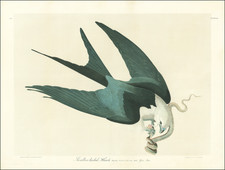
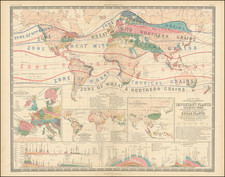
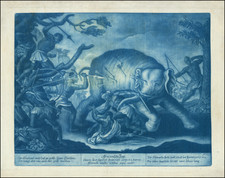
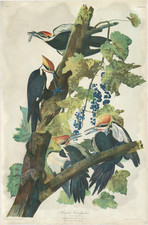
![[ Locomotive ]](https://storage.googleapis.com/raremaps/img/small/85309.jpg)
